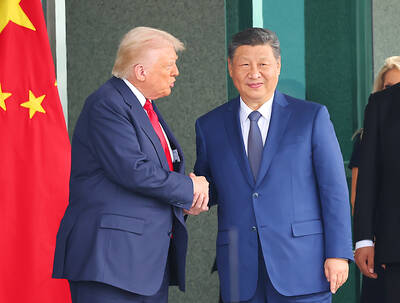Japan’s economic recovery gained momentum last month as manufacturing accelerated and consumer prices rose for a second straight month, despite weaker household spending and retail sales.
The data released yesterday showed the consumer price index (CPI) rose 0.7 percent last month from a year earlier, for the second straight month of gains. That suggests efforts to break free of years of demand-dampening deflation are progressing. The CPI rose 0.2 percent in June.
However, the core index, which excludes food and energy prices, fell 0.1 percent.
The Ministry of Economy, Trade and Industry said industrial output rose 1.6 percent from a year earlier and 3.2 percent from the month before, in a sign the recovery is taking hold. It forecasts further expansion this month and next month.
“Income and other data show quite positive signs of recovery,” RBS Japan Securities economist Junko Nishioka said.
The government has boosted spending and pushed for ultra-loose monetary policies aimed at generating inflation. It says that will help perk up demand and, in response, investment and employment, ending years of stagnation.
However, economists say that without matching increases in wages, rising prices and planned tax hikes could actually weaken the consumer demand that accounts for the bulk of business activity, undermining any economic rebound.
Average household spending fell 1.4 percent last month from a year earlier, despite slight improvements in income and the jobless rate, which fell to 3.8 percent from 3.9 percent the month before.
Retail sales fell 0.3 percent last month from a year earlier for the first decline in three months. Sales of clothing and other items sagged, while food sales rose.
The government attributed at least some of the limpness of demand to hot weather.
However, with prices rising, many consumers already are feeling a pinch, Capital Economics said in a commentary.
“Perhaps the biggest threat to consumer spending is the rise in inflation,” it said, adding that bustling sales earlier in the summer were probably helped by bonus payments and overtime in June.
“Households are probably well aware that once the summer bonus season is over, wages will likely continue shrinking, depressing their purchasing power,” it said.
Still, the overall positive tone of last month’s data will likely bolster support for pushing ahead with a sales tax planned for April 1 next year. A decision on that plan is due within the next month.
The anticipated 3 percentage point increase in the nationwide sales tax to 8 percent will undoubtedly be a blow, Ishioka said, but she expects it to be short-lived given the currently favorable trends.
“People’s sentiment is improving. I think the fundamental conditions are OK,” she said.

RUN IT BACK: A succesful first project working with hyperscalers to design chips encouraged MediaTek to start a second project, aiming to hit stride in 2028 MediaTek Inc (聯發科), the world’s biggest smartphone chip supplier, yesterday said it is engaging a second hyperscaler to help design artificial intelligence (AI) accelerators used in data centers following a similar project expected to generate revenue streams soon. The first AI accelerator project is to bring in US$1 billion revenue next year and several billion US dollars more in 2027, MediaTek chief executive officer Rick Tsai (蔡力行) told a virtual investor conference yesterday. The second AI accelerator project is expected to contribute to revenue beginning in 2028, Tsai said. MediaTek yesterday raised its revenue forecast for the global AI accelerator used

Taiwan Semiconductor Manufacturing Co (TSMC, 台積電) has secured three construction permits for its plan to build a state-of-the-art A14 wafer fab in Taichung, and is likely to start construction soon, the Central Taiwan Science Park Bureau said yesterday. Speaking with CNA, Wang Chun-chieh (王俊傑), deputy director general of the science park bureau, said the world’s largest contract chipmaker has received three construction permits — one to build a fab to roll out sophisticated chips, another to build a central utility plant to provide water and electricity for the facility and the other to build three office buildings. With the three permits, TSMC

TEMPORARY TRUCE: China has made concessions to ease rare earth trade controls, among others, while Washington holds fire on a 100% tariff on all Chinese goods China is effectively suspending implementation of additional export controls on rare earth metals and terminating investigations targeting US companies in the semiconductor supply chain, the White House announced. The White House on Saturday issued a fact sheet outlining some details of the trade pact agreed to earlier in the week by US President Donald Trump and Chinese President Xi Jinping (習近平) that aimed to ease tensions between the world’s two largest economies. Under the deal, China is to issue general licenses valid for exports of rare earths, gallium, germanium, antimony and graphite “for the benefit of US end users and their suppliers

Dutch chipmaker Nexperia BV’s China unit yesterday said that it had established sufficient inventories of finished goods and works-in-progress, and that its supply chain remained secure and stable after its parent halted wafer supplies. The Dutch company suspended supplies of wafers to its Chinese assembly plant a week ago, calling it “a direct consequence of the local management’s recent failure to comply with the agreed contractual payment terms,” Reuters reported on Friday last week. Its China unit called Nexperia’s suspension “unilateral” and “extremely irresponsible,” adding that the Dutch parent’s claim about contractual payment was “misleading and highly deceptive,” according to a statement